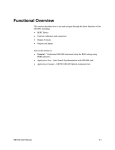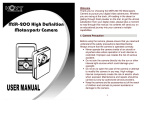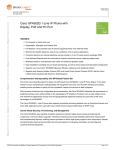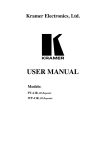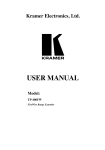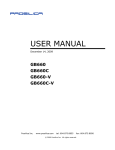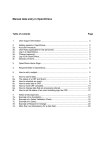Download Chapter 1 - Getting Started
Transcript
Getting Started GB1400 Pattern Generator and Error Detector Features • Test digital data transmission up to 1400 Mb/s • Set Data Rate with 1 kHz resolution • Vary Clock and Data timing with 5 pS resolution • Phase-Synchronous Clock and Data Edge Tracking • Up to 1-Mbit custom data pattern memory • Measure Eye-Width at Specific BER Automatically • Auto-Synchronization Rx/Tx Lock-up • Front panel or computer control operation The GB1400 is a general-purpose 1400 Mb/s bit error rate tester (BERT) built to meet the exacting standards of design engineers who need to verify and characterize high-speed serial data transmission circuits, interfaces and systems. While primarily a lab instrument, the GB1400’s compact design, full computer programmability and relatively light weight also enable it to serve in manufacturing ATE and field test applications. The quality of a digital link depends on many factors, but everything comes down to the issue of whether the circuit exhibits a satisfactory BER (bit error rate) and has sufficient margin to function under stress conditions. The GB1400 has all of the features you expect in a general-purpose BERT, and some you expect only in more expensive instruments, such automated eye-width measurements at a specified BER, and the ability to accept an external real-time data stream for bit error testing. Also, the GB1400 has options to add advanced features, such as Burst Mode (which also extends external clock range down to 150 kb/s), and a 1-Mbit programmable pattern memory option. GB1400 User Manual 1-1 Getting Started Symmetrical, Low-Jitter Output Waveforms The GB1400 generates low-jitter, symmetrical waveforms over its entire operating frequency range. The clock and data ports provide both true and inverted output signals. The instrument can drive single-ended or differential ECL inputs. Applications The GB1400 is focused on the research, design, and manufacturing of telecommunication components, modules, or links operating at data rates to 1400 Mb/s. It is frequently employed in testing and development well under this top speed rating, where sharp clock and data waveforms are especially desired, or where additional frequency range is thought to be needed in the future. Sample Applications • Development of Gigabit LAN/Data Comm Devices: • High-Speed Fibre Channel, Ethernet • Digital Video (MPEG, SDV, HDDV) • Wideband Satellite Data Links • SONET/SDH Network Devices up to OC-12e/STM4e • High-speed GaAs/ECL/E/O device testing • Test Clock Recovery Circuits • Parallel-to-Serial Analysis with Tektronix MB100 • Testing of High Speed Fibre Channel links up to 1,063 Mb/s • Gigabit Ethernet at 1,250 Mb/s. • Testing of high-speed Optical Busses (Opto Bus, Opto Bahn) at 800 Mb/s per channel. • Satellite system testing and TDMA (Burst Mode) at 400, 800 Mb/s • GaAs, ECL and optical component testing PRBS Or User-Defined Test Patterns The GB1400 can generate pseudo-random bit sequences (PRBS) up to 223−1 bits and others up to 1-Mbit in length, via user-programmable patterns. Patterns can be created locally using setup menus or externally by using a workstation or PC. A PC Windows based Pattern Editor software package comes with the 1-Mbit Memory Option. Externally created patterns can be downloaded via the GPIB or RS-232 port. All user patterns are saved in battery-backed RAM. 1-2 GB1400 User Manual Getting Started Adjustable Inputs For Maximum Flexibility The clock and data ports on the GB1400 Error Detector accept both true and inverted inputs. Single-ended or differential signals can be internally terminated. Input data delay is adjustable over a 4 ns range to accommodate different clock and data signal path delays. Auto Search For Easy Setup Auto search greatly simplifies the Error Detector setup. The GB1400 Error Detector automatically synchronizes to the incoming signal by 1) Setting the input data decision voltage to its optimum value; 2) Adjusting input data delay for an optimum clock/data phase relationship; 3) Selecting the correct PRBS test pattern; and 4) selecting the correct pattern polarity (normal or inverted). It synchronizes with any pattern sourced by a gigaBERT Pattern Generator. It can perform a bit-by-bit comparison of an external data stream via the Reference Data input. Thus the GB1400 can perform bit error analysis on any data pattern with a known good reference pattern. Powerful Analysis And Reporting Functions The GB1400 performs a full-rate, bit-by-bit analysis of the received signal. Bit error results are then used to calculate three bit error rate (BER) measures. Total BER is calculated from the last power-on or reset. Window BER is calculated over a sliding window specified in terms of time (1 second to 24 hours) or bits (18- to 116-bits). Test BER is calculated from the start of the current test. A hard copy of all test results can be generated locally by connecting a printer to the parallel printer port or GPIB or RS-232 port. Reports may be printed when an error is detected, at the end of test intervals, or both. Front Panel Or Automated Operation The GB1400 provides easy operation augmented by set-up store and recall. Clear, concise LCD displays of setup and results make it easy to use. The 1 Megabit memory option for both the Pattern Generator and the Error Detector is sufficient for storing and outputting complex data such as SONET frames, ATM cells, MPEG digital video, etc, allowing designers to simulate “live” traffic. The GB1400 Pattern Generator and Error Detector can be controlled via the GPIB or RS-232 interface ports. The gigaBERT remote command set includes commands for all setup menus and front panel selections. The status of front panel indicators and test results can be remotely accessed. Burst Mode BURST mode, allows for operation with non-continuous external clocks. Use of BURST mode requires ECL-level signals with a minimum rate during the burst of 150 kHz. This is an option to the GB1400. See a write-up on Burst Mode at the end of the Functional Overview section of Chapter 2. GB1400 User Manual 1-3 Getting Started Ordering Information gigaBERT GB1400 1400 Mb/s BERT Generator and Detector. Not available in Europe. Includes: Power Cord, Manual. Opt. 02 - 75 Ohm Both Sets. Opt. 05 - BURST Mode Both Sets. Opt. 07 - Positive ECL (Pattern Generator Only). Opt. 08 - 1-Mbit RAM WORD Both Sets & PC Pattern Editor Software. Opt. 2M - Rack Mounts - 2 rackmount kits Opt. A3 - Australian 240 V, 50 Hz. gB1400T 1400 Mb/s BERT Pattern Generator. Opt. 02 - 75 Ohm Pattern Generator Only. Opt. 05 - BURST Mode Pattern Generator Only. Opt. 07 - Positive ECL Pattern Generator Only Opt. 08 - 1-Mbit RAM WORD, Generator Only, w/ PC Pattern Edit software Opt. 1M - Rack Mount. Opt. A3 - Australian 240 V, 50 Hz. gB1400R 1400 Mb/s BERT Error Detector. Opt. 02 - 75 Ohm Error Detector Only. Opt. 05 - BURST Mode Error Detector Only. Opt. 08 - 1-Mbit RAM WORD, Detector Only w/ PC Pattern Edit Software Opt. 1M - Rack Mount. Opt. A3 - Australian 240 V, 50 Hz 1-4 GB1400 User Manual Getting Started GB Comparison Feature Transmitter Frequency range Internal Clock Source External Clock External Clock w/Burst Mode1 Freq Resolution (Internal Clock) Clock /Data Output Amplitude Clock/Data Output Offset Clock/Data Threshold Resolution Std. Programmable Memory Optional Memory PRBS Patterns (2n-1) Burst Mode (External Clk Only) Receiver Frequency range w/Burst Mode1 Burst Mode (Ext Clk Only) Clock/Data Input levels (max) Clock Input Threshold Data Input Threshold Clock/Data Threshold Resolution Clock/Data Input Terminations Single-Ended operation Clk/Data Delay Range / Resolution GB660/CSA907A Tx and Rx GB700 Tx and Rx GB1400 Tx and Rx 150 kHz to 700 MHz 150 kHz to 700 MHz 150 kHz to 700 MHz 1 kHz 150 kHz to 705 MHz 150 kHz to 705 MHz 150 kHz to 705 MHz 1 kHz 1 MHz to 1400 MHz 1 MHz to 1400 MHz 150 kHz to 1400 MHz 1 kHz (was 10 kHz) 500mV to 2.0 V 500mV to 2.0 V 500mV to 2.0 V -2.0V to +1.8 V -2.0V to +1.8 V 50 mV steps 50 mV steps -2.0V to +1.0 V -2.0V to +1.8 V with PECL opt. 50 mV steps 16 bits 128 Kbits 7,15,17,20,23 Standard Feature 128 Kbits none 7,15,17,20,23 Standard Feature 16 bits 1 Mbit 7,15,17,20,23 Optional Feature 150 kHz to 705 MHz 150 kHz to 705 MHz Standard Feature 500 mV to 6.0 V p-p -3.00 to +4.5 V -3.00 to +4.5 V 50 mV steps 150 kHz to 705 MHz 150 kHz to 705 MHz Standard Feature 500 mV to 6.0 V p-p -3.00 to +4.5 V -3.00 to +4.5 V 50 mV steps 1 MHz to 1400 MHz 150 kHz to 1400 MHz Optional Feature 500 mV to 2.0 V p-p Fixed threshold levels -1.5V to 1.0 V 50 mV steps GND, AC, -2V, +3V Automatic selection GND, AC, -2V, +3V Automatic selection ±4 ns in 100 pS steps ±4 ns in 20 pS steps GND, AC, -2V Requires external cable2 ±4 ns in 5 pS steps Note 1 Burst mode operation requires ECL levels and is DC coupled Note 2 Single-ended operation requires ext. cable connection from rear panel DATA THRESHOLD SMA GB1400 User Manual 1-5 Getting Started GB1400 Instrument Configurations - Standard and Burst Option GB1400 instruments are sold with and without the BURST option. To determine if the burst option is installed in a GB1400, press the F1 key several times until you get to the UTIL menu. Then select the OPTION menu. The OPTIONS menu will tell you if the Burst option is installed in the unit. External indications of the BURST option are unique labels for both transmitter and receiver. See a write-up on Burst Mode at the end of the Functional Overview section of Chapter 2. GB1400 with no Burst Option Standard instrument configuration All standard configuration GB1400 Generators (TX) (no burst option) have an AC coupled external clock input. All standard configuration GB1400 Analyzers (RX) (no burst option) have AC coupled paths in the receiver clock input circuitry. GB1400 with Burst Option When the BURST option is installed in the GB1400, the AC coupled paths in both transmitter and receiver are eliminated. This will also change several specifications listed in the table below. External clock inputs to the GB1400 transmitter must be ECL levels when the BURST option is installed. Clock inputs into the GB1400 receiver must be ECL levels and are terminated into 50 Ohms to -2V. GB1400 Clock Signals for Standard and Burst and Instruments Standard Burst (Option) GB1400 TX External Clock Input 50 Ohm, 2V max 50 Ohm to -2V ECL 50 Ohm, 2.0V max 50 Ohm ECL Levels GB1400 RX Clock Input 1-6 GB1400 User Manual Getting Started Initial Self-Check Procedure You may perform the following procedure as an initial self-check of your GB1400 Generator and Analyzer. It is also a useful introduction to the basic features and operation of the GB1400. The fan openings of the GB1400 needs 2-inches of clearance for proper ventilation. Procedure 1. Make sure both the Generator and Analyzer are equipped with the proper fuse. 2. Make sure that the Generator and Analyzer rear-panel power switches are ON, and that their front-panel power switches are in the STBY position. 3. Plug both instruments into grounded (three-conductor) AC power outlets. 4. Connect a 50-Ohm SMA cable from the Generator CLOCK output to the Analyzer CLOCK input. 5. Connect a 50-Ohm SMA cable from the Generator DATA output to the Analyzer DATA input. 6. Connect a 50-Ohm SMA cable from the Analyzer rear panel DATA THRESHOLD output to the Analyzer DATA BAR input (required for single-ended data inputs). 7. Power the Generator while pressing and holding its VIEW ANGLE, MSB 1 and (PATTERN) CLEAR keys simultaneously. Release the key after the message Default Settings appears in the display. Repeat this procedure with the Analyzer. This will force both the Generator and Analyzer to power up using factory default settings. 8. Set up the Generator clock and data outputs using controls in the OUTPUT box as follows: Set this parameter… DATA amplitude. to this value 2 volts DATA baseline offset -1 volt CLOCK amplitude 2 volts CLOCK baseline offset -1 volt GB1400 User Manual … using this procedure. Press the DATA key. Press AMPLITUDE up/down keys until data amplitude is set to 2.00V. Press BASELINE OFFSET up/down keys until data baseline offset is set to -1.00V. Press CLOCK. Press AMPLITUDE up/down keys until clock amplitude is set to 2.00V. Press BASELINE OFFSET up/down keys until clock baseline OFFSET is set to 1.00V. 1-7 Getting Started 9. Set Generator pattern to a 223-1 bit PRBS using controls in the PATTERN box as follows: a. Press PRBS. b. Press the pattern up/down keys until PATTERN is set to PN 23. 10. Verify that the Generator error rate generator is off. If the LED in the error inject RATE key is on, then press RATE one or more times until it turns off. 11. Verify that the Analyzer auto-search function is enabled. If the LED in the AUTO SEARCH key is off, then press AUTO SEARCH one time to turn it on. At this point, verify that the green LOCK LED in the Analyzer SYNC box is on. 12. Zero all Analyzer error counts by pressing CLEAR in the ERROR DETECTION group. 13. Reset all Analyzer history LEDs by pressing CLEAR in the ERROR HISTORY group. 14. Verify GB1400 Analyzer can detect errors by pressing the Generator error inject SINGLE key several times. Verify that the Number of Errors count displayed by the Analyzer increments each time the Generator SINGLE key is pressed. In effect you are now performing a bit error rate test on the test cables connecting the GB1400 Generator and Analyzer. In an actual BER test, GB1400 Generator clock and data outputs would be connected to inputs on a "device under test" (DUT) while GB1400 Analyzer inputs would be connected to outputs on the DUT. 1-8 GB1400 User Manual












